Find your degree
 Maryland was one of the original 13 colonies in America and is a Mid-Atlantic state. With more than half of the counties in the state being on the Chesapeake Bay, it boasts 4,000 miles of shoreline. The Chesapeake Bay area is well known for its seafood cuisine. In fact, one of the nicknames for Maryland is the Chesapeake Bay State. Other nicknames for Maryland include The Old Line State, The Free State, Little America, and America in Miniature.
Maryland was one of the original 13 colonies in America and is a Mid-Atlantic state. With more than half of the counties in the state being on the Chesapeake Bay, it boasts 4,000 miles of shoreline. The Chesapeake Bay area is well known for its seafood cuisine. In fact, one of the nicknames for Maryland is the Chesapeake Bay State. Other nicknames for Maryland include The Old Line State, The Free State, Little America, and America in Miniature.
While Annapolis is the capital city of Maryland, Baltimore is the largest city within the state. Fort McHenry was the birthplace of the U.S. national anthem and rests at the mouth of Baltimore’s Inner Harbor. Due to the unique shape of the state, it borders Pennsylvania to its North and Delaware to its East. To the South is Virginia and our nation’s capital, Washington, DC. West Virginia also borders Maryland on the Southwestern portion of the state.
Maryland offers a large number of historic tourist attractions. In addition to the aforementioned Fort McHenry, places to visit include the State House in Annapolis, Clara Barton’s home, Frederick Douglass’ home, Colonial Maryland in St. Mary’s City, B&O Railroad Museum, the Bucktown Village Store, Dorchester County, and many more. Amid the parks, museums, zoos, and other attractions in Maryland, some of the must-sees include the National Aquarium, Ocean City, and the Maryland Science Center.
Higher education in Maryland is impressive with more than 57 colleges and universities within the state. The University System of Maryland itself has 12 individual institutions, 11 which are degree-granting campuses and one is a research facility. The state boasts over 150 private career schools and 16 community colleges. The Maryland Higher Education Commision states that “one-third of its residents 25 and older have a bachelor’s degree or higher, which is the 4th highest percentage among all states”.
OnlineCollegePlan is proud to share its ranking of the Top 10 Best Online Colleges in Maryland. This ranking is for 4-year institutions and below you can find our detailed methodology.
Methodology
Sources used for this ranking are: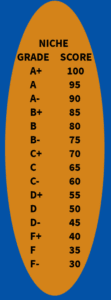
- CollegeData
- National Center for Education Statistics
- Niche
- individual school websites
First and foremost for this ranking, the presence of online programs or courses is a necessity. In some cases, there may be minimal participation required on campus. This can be an excellent reason to choose a local school, even for online programs. Schools were ranked by adding together the percentage numbers for freshman satisfaction and graduation rates. Then, a numerical equivalent of the overall grade provided by Niche, with A+ being 100, A being 95, and so on in this manner, was added to these numbers.
With affordability being an important factor as well, the (residential) cost of attendance has been converted in accordance with our affordability scale (to the right) and added to the previous numbers resulting in the final ranking score. Many colleges cost more for non-residential students to attend which can be another excellent reason to choose a local school for online studies.
Example: 87 (percent freshman satisfaction) + 52 (graduation percent) + 80 (A- Overall Grade) + 40 (affordability score) = 259 (final score for ranking)
Note: None of the institutions in this ranking or any of OnlineCollegePlan’s rankings have received preferential treatment, nor have we been requested to do so. Our methodology is fully disclosed so that anyone is able to arrive at the same ranking using the formula as explained. Also, no schools in this ranking are for-profit schools. Some schools may have been excluded due to incomplete data.
Students may also be interested in, “Top 100 Best Online Colleges” which covers the overall best institutions in the United States. Curious about the best schools by location? We’ve got you covered. The Ultimate Guide to Online Colleges may also be helpful.
Array
Array

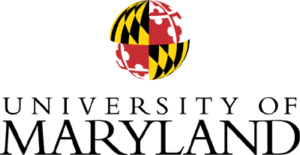 The University of Maryland in College Park, Maryland which was founded in 1856 and is the flagship institution of the University of Maryland system. UMD has gone through a number of changes over the years. One of the most devastating being a fire that destroyed most of the campus including the school records that occurred in 1912. Thankfully, none of the faculty or students died and only two students failed to return to continue their education at UMD.
The University of Maryland in College Park, Maryland which was founded in 1856 and is the flagship institution of the University of Maryland system. UMD has gone through a number of changes over the years. One of the most devastating being a fire that destroyed most of the campus including the school records that occurred in 1912. Thankfully, none of the faculty or students died and only two students failed to return to continue their education at UMD.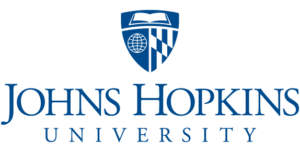 Johns Hopkins University, located in Baltimore, Maryland, was established in 1876. The university is named for its first benefactor, Johns Hopkins who believed in the importance of improving public health in Baltimore as well as across the country. JHU has the distinction of being considered the first research university in the United States. The school has a stellar reputation and is recognized in the top 10 Best National Universities Rankings by U.S. News & World Report. Online College Plan has included the university in several rankings including our
Johns Hopkins University, located in Baltimore, Maryland, was established in 1876. The university is named for its first benefactor, Johns Hopkins who believed in the importance of improving public health in Baltimore as well as across the country. JHU has the distinction of being considered the first research university in the United States. The school has a stellar reputation and is recognized in the top 10 Best National Universities Rankings by U.S. News & World Report. Online College Plan has included the university in several rankings including our 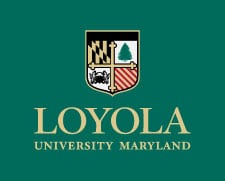 Loyola University Maryland is located in the city of Baltimore and was founded in 1852. The university was the first college to bear the name of St. Ignatius of Loyola. Loyola is the ninth oldest Jesuit institution of higher learning in the United States, of which there are 28 in total.
Loyola University Maryland is located in the city of Baltimore and was founded in 1852. The university was the first college to bear the name of St. Ignatius of Loyola. Loyola is the ninth oldest Jesuit institution of higher learning in the United States, of which there are 28 in total. Salisbury University, or SU, was founded in 1925 and is located in its namesake city of Salisbury, Maryland. It is a public university and member of the University System of Maryland. Today the school serves more than 8,500 students with the majority being undergraduates.
Salisbury University, or SU, was founded in 1925 and is located in its namesake city of Salisbury, Maryland. It is a public university and member of the University System of Maryland. Today the school serves more than 8,500 students with the majority being undergraduates. Towson University is in Towson, Maryland which is only about 55 miles from our capital city of Washington, D.C. The roots of the school date back to 1865 when the General Assembly of Maryland established the school which would become Towson University. The original name when it opened in 1866 was Maryland State Normal School. Later, in 1935, the school became Maryland State Teachers College at Towson, then became Towson State University in 1976. It was 1988 when the school became a part of the University System of Maryland, and in 1997 the school officially dropped the “State” from the name and became Towson University as it is known today.
Towson University is in Towson, Maryland which is only about 55 miles from our capital city of Washington, D.C. The roots of the school date back to 1865 when the General Assembly of Maryland established the school which would become Towson University. The original name when it opened in 1866 was Maryland State Normal School. Later, in 1935, the school became Maryland State Teachers College at Towson, then became Towson State University in 1976. It was 1988 when the school became a part of the University System of Maryland, and in 1997 the school officially dropped the “State” from the name and became Towson University as it is known today.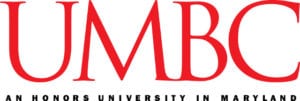 University of Maryland Baltimore County is in the bustling city of Baltimore, Maryland. UMBC was established in 1966 and is a member of the University System of Maryland. It was also the first collegiate institution to allow enrollment to all students regardless of race. Serving more than 13,000 students, UMBC has the fourth highest enrollment of the 12 University System of Maryland institutions.
University of Maryland Baltimore County is in the bustling city of Baltimore, Maryland. UMBC was established in 1966 and is a member of the University System of Maryland. It was also the first collegiate institution to allow enrollment to all students regardless of race. Serving more than 13,000 students, UMBC has the fourth highest enrollment of the 12 University System of Maryland institutions. McDaniel College is a private, liberal arts college in Westminster, Maryland with a satellite campus in Budapest, Hungary. Initially established in 1867, and was named Western Maryland College until it changed its name to McDaniel College in July of 2002. The college is named in honor of William Roberts McDaniel, with the college history poetically stating that his “65-year association with the College as student, professor, administrator, trustee, parent, and grandparent helped shape its destiny and today personifies its mission”.
McDaniel College is a private, liberal arts college in Westminster, Maryland with a satellite campus in Budapest, Hungary. Initially established in 1867, and was named Western Maryland College until it changed its name to McDaniel College in July of 2002. The college is named in honor of William Roberts McDaniel, with the college history poetically stating that his “65-year association with the College as student, professor, administrator, trustee, parent, and grandparent helped shape its destiny and today personifies its mission”.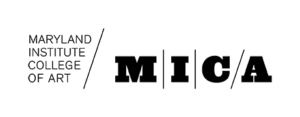 Maryland Institute College of Art (MICA) is in the large city of Baltimore, Maryland. Founded in 1826, it is one of the oldest art schools in America. MICA is often considered to be one of the finest art schools in the nation with a reputation for excellence in its academics. In 2014, MICA was ranked #7 in the country for its fine arts programs by U.S. News & World Report. Meanwhile, two years previous, MICA’s Graphic Design Master of Fine Arts program was ranked third in the U.S.
Maryland Institute College of Art (MICA) is in the large city of Baltimore, Maryland. Founded in 1826, it is one of the oldest art schools in America. MICA is often considered to be one of the finest art schools in the nation with a reputation for excellence in its academics. In 2014, MICA was ranked #7 in the country for its fine arts programs by U.S. News & World Report. Meanwhile, two years previous, MICA’s Graphic Design Master of Fine Arts program was ranked third in the U.S. Notre Dame of Maryland University (NDMU) is located in the city of Baltimore and was established in 1873. NDMU is one of the pioneers in higher education for women in the United States. In fact, it became the first women’s Roman Catholic 4-year institution in the country in 1896.
Notre Dame of Maryland University (NDMU) is located in the city of Baltimore and was established in 1873. NDMU is one of the pioneers in higher education for women in the United States. In fact, it became the first women’s Roman Catholic 4-year institution in the country in 1896. Morgan State University is the largest historically black university (HBCU) in Maryland and is in the city of Baltimore. Founded in 1872 and named the Centenary Bible Institute, the school was initially a seminary school. The school was later, in 1890, renamed as Morgan College in honor of the first chairman of its Board of Trustees, Reverend Lyttleton Morgan.
Morgan State University is the largest historically black university (HBCU) in Maryland and is in the city of Baltimore. Founded in 1872 and named the Centenary Bible Institute, the school was initially a seminary school. The school was later, in 1890, renamed as Morgan College in honor of the first chairman of its Board of Trustees, Reverend Lyttleton Morgan.